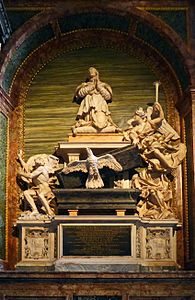Paolo Posi
Paolo Posi (* 1708 in Siena ; † January 3, 1776 in Rome ) was an Italian architect of the Italian late baroque in transition to classicism .
life and work
Posi was the son of the carpenter Giuseppe Posi. His mother's mother's name is unknown. In Siena he learned the basics of mathematics and architecture. In the late 1720s he went to Rome, where he worked in the workshop of Filippo Barigioni (1672–1753). In 1728 he took part in a competition at the Academy S. Luca and won a first prize together with Tommaso Asprucci. He only made an appearance with his work on the Cathedral of Naples. In Rome he was a builder at the Papal Palace and the Pantheon. For years he arranged the fireworks decorations on the Piazza Farnese for the Peter and Paul Festival in Rome. From 1751 he was an architect for the Colonna family . He is regarded as the teacher of Giacomo Quarenghi , Giuseppe Piermarini and Giuseppe Palazzi. Paolo Posi is buried in the church of Santi Bonifacio e Alessio in Rome (fig.) .
Works
Paolo Posi was involved as an architect in the following buildings or was responsible for the execution:
- 1734–1742 renovation of the apse of the Cathedral of San Gennaro in Naples
- 1739 sculptures for the apse of the cathedral of Naples together with Pietro Bracci
- 1750 renovation of the choir of Santa Maria dell'Anima in Rome
- 1755–1761 courtyard facade of the Palazzo Colonna in Rome
- 1756 Vestibule for the Museo Sacro of the Vatican Museums in Rome
- 1756 renovation of the Pantheon in Rome
- 1758 P. Posi is invited together with Carlo Murena and Carlo Marchionni to present a model for the portals of St. Peter's Church .
- Palazzo Sergardi, the former Monastero delle Derelitte, in Siena
- Villa Farsetti in Santa Maria di Sala
- Monastery and church of Santa Maria delle Grazie near Senigallia
- 1766–1775 rebuilding of the church of Santa Caterina da Siena in Rome
- Expansion of the church of Sant'Andrea delle Fratte in Rome
In his last creative period, Paolo Posi designed tombs and altars:
- 1766–67 Design and planning for the tombs of the cardinals Lorenzo and Renato Imperiali in Sant'Agostino in Campo Marzio , Rome
- 1771 Design and planning for the tomb of Maria Flaminia Chigi-Odescalchi in Santa Maria del Popolo , Rome
- 1769 designs for the altar of the Chapel of the Immaculate Conception in San Carlo al Corso , Rome (attributed)
literature
- Georg Kaspar Nagler : Posi, Paolo . In: New general artist Lexicon or messages from the life and works of painters, sculptors, architects, engravers, die cutter, lithographer, illustrator, Medals and Ivory, etc . tape 11 : Passe, Simon de - Powle, G . Fleischmann, Munich 1841, p. 532-533 ( books.google.de ).
- Posi, Paolo . In: Hans Vollmer (Hrsg.): General lexicon of fine artists from antiquity to the present . Founded by Ulrich Thieme and Felix Becker . tape 27 : Piermaria – Ramsdell . EA Seemann, Leipzig 1933, p. 295 .
- Raffaella Catini: Posi, Paolo. In: Raffaele Romanelli (ed.): Dizionario Biografico degli Italiani (DBI). Volume 85: Ponzone-Quercia. Istituto della Enciclopedia Italiana, Rome 2016.
Web links
- Enciclopedia Treccani (Italian)
- Paolo Posi (Italian, 1708–1776) artnet.de
Individual evidence
- ↑ Rafaella Catini: Vita e committenza artistica di Paolo Posi, Senese architetto . In: Bollettino del Centro di Studi per la Storia dell'Architettura . No. 42-44 . Gangemi Editore spa, 2012, ISBN 978-88-492-6786-0 , p. 203–205 (Italian, books.google.de - excerpt).
- ^ Kurt von Domarus: The beautiful tomb of Cardinal Giuseppe Renato Imperiali… In: Pietro Bracci, contributions to the Roman art history of the XVIII. Century . Heitz, Strasbourg 1915, p. 29 ( Textarchiv - Internet Archive ).
| personal data | |
|---|---|
| SURNAME | Posi, Paolo |
| BRIEF DESCRIPTION | Italian architect |
| DATE OF BIRTH | 1708 |
| PLACE OF BIRTH | Siena |
| DATE OF DEATH | January 3, 1776 |
| Place of death | Rome |





